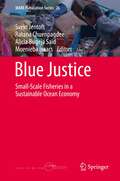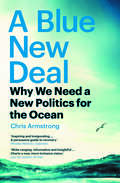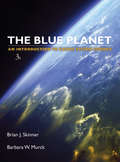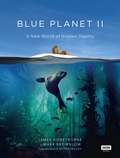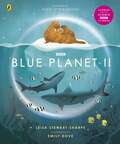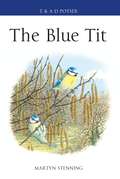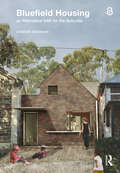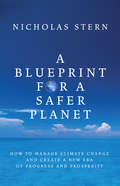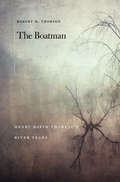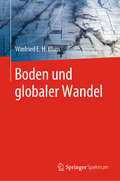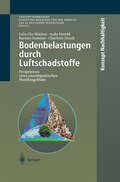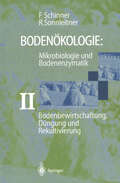- Table View
- List View
Blue Justice: Small-Scale Fisheries in a Sustainable Ocean Economy (MARE Publication Series #26)
by Svein Jentoft Ratana Chuenpagdee Alicia Bugeja-Said Moenieba IsaacsFor small-scale fisheries around the world, the Blue Growth and Blue Economy initiatives may provide sustainable development, but only insofar as they align with the global consensus enshrined in the Voluntary Guidelines for Securing Sustainable Small-Scale Fisheries in the context of Food Security and Poverty Eradication. If states do nothing to fulfill the promises they made when they endorsed these guidelines in 2014, the Blue Economy will come at a loss for small-scale fisheries and further their marginalization in the ocean economy. Under the umbrella of Blue Justice, this book demonstrates that these risks are real and must be considered as states implement their sustainable ocean development plans. These are human rights issues, which are embedded into governance principles and institutions and which make a difference for small-scale fisheries people in their daily lives. In stressing the importance of policies and institutions that build on the experiences of small-scale fisheries people in the contexts in which they operate, this book draws on case studies of small-scale fisheries from countries on all continents to clarify what Blue Justice entails for small-scale fisheries and make suggestions for real change. “Through the Blue Justice paradigm, this book flags the relevance of recognizing the potential impact that different factors, including the Blue Economy approach, could bring to fishing communities, their livelihoods, cultural traditions, and other potential multidimensional conflicts. Vulnerability in fishing communities can increase and inequalities can be reinforced at different levels if individuals and community capabilities are not strengthened… A first of its kind, not to be missed, this book is informative, purposeful, and pertinent in an era of change”. Silvia Salas, CINVESTAV, Marine Resources Department, Mérida, Mexico "The studies reveal that Blue Justice is a ‘governability’ issue, which requires establishing ‘right’ institutions, that are transdisciplinary (integrated), participatory, and holistic. It is implicit from these writings that the SSF Guidelines and Blue Growth initiatives do not form two different discourses, and that the implementation of the former would resolve many of the justice issues caused by the latter, in favor of small-scale fisheries and their communities". Oscar Amarasinghe, Professor & Chancellor, Ocean University of Sri Lanka and President, Sri Lanka Forum for Small Scale Fisheries (SLFSSF)
Blue Machine: How the Ocean Shapes Our World
by Helen CzerskiWINNER OF THE 2024 WAINWRIGHT PRIZE FOR CONSERVATION FINANCIAL TIMES 2023 HIGHLIGHT'Helen Czerski weaves together physics and biology, history and science, in a beautifully poetic way.'Professor Alice Roberts'In Helen Czerski's hands, the mechanical becomes magical. An instant classic.'Tristan Gooley, author of How to Read Water'Blue Machine is quite simply one of the best books I have ever read.'Dr George McGavin, zoologist, entomologist and broadcaster'A fascinating dive into the essential engine that drives our world. Czerski brings the oceans alive with compelling stories that masterfully navigate this most complex system.'Gaia Vince, science journalist, broadcaster and author of Nomad Century All of the Earth's ocean, from the equator to the poles, is a single engine powered by sunlight - a blue machine.Earth is home to a huge story that is rarely told - that of our ocean. Not the fish or the dolphins, but the massive ocean engine itself: what it does, why it works, and the many ways it has influenced animals, weather and human history & culture.In a book that will recalibrate our view of this defining feature of our planet, physicist Helen Czerski dives deep to illuminate the murky depths of the ocean engine, examining the messengers, passengers and voyagers that live in it, travel over it, and survive because of it. From the ancient Polynesians who navigated the Pacific by reading the waves to permanent residents of the deep such as the Greenland shark that can live for hundreds of years, she explains the vast currents, invisible ocean walls and underwater waterfalls that all have their place in the ocean's complex, interlinked system.Timely, elegant and passionately argued, Blue Machine presents a fresh perspective on what it means to be a citizen of an ocean planet. The understanding it offers is crucial to our future. Drawing on years of experience at the forefront of marine science, Helen Czerski captures the magnitude and subtlety of Earth's defining feature, showing us the thrilling extent to which we are at the mercy of this great engine.
A Blue New Deal: Why We Need a New Politics for the Ocean
by Chris ArmstrongAn urgent account of the state of our oceans today—and what we must do to protect themThe ocean sustains life on our planet, from absorbing carbon to regulating temperatures, and, as we exhaust the resources to be found on land, it is becoming central to the global market. But today we are facing two urgent challenges at sea: massive environmental destruction, and spiraling inequality in the ocean economy.Chris Armstrong reveals how existing governing institutions are failing to respond to the most pressing problems of our time, arguing that we must do better. Armstrong examines these crises—from the fate of people whose lands will be submerged by sea level rise, to the exploitation of people working in fishing, to the rights of marine animals—and makes the case for a powerful World Ocean Authority capable of tackling them. A Blue New Deal presents a radical manifesto for putting equality, democracy, and sustainability at the heart of ocean politics.
The Blue Planet: An Introduction to Earth System Science
by Brian J Skinner Barbara W MurckThe Blue Planet: An Introduction to Earth System Sciences, 3rd Edition is an innovative text for the earth systems science course. It treats earth science from a systems perspective, now showing the five spheres and how they are interrelated. There are many photos and figures in the text to develop a strong understanding of the material presented. This along with the new media for instructors makes this a strong text for any earth systems science course.
Blue Planet II
by James Honeyborne Mark BrownlowTake a deep breath and dive into the mysteries of the ocean.Our understanding of ocean life has changed dramatically in the last decade, with new species, new behaviours, and new habitats being discovered at a rapid rate. Blue Planet II, which accompanies an epic 7-part series on BBC1, is a ground-breaking new look at the richness and variety of underwater life across our planet.From ambush hunters such as the carnivorous bobbit worm to cuttlefish mesmerising their prey with a pulsating light display, Blue Planet II reveals the never-before-seen secrets of the ocean. With over 200 breath-taking photographs and stills from the BBC Natural History Unit's spectacular footage, each chapter of Blue Planet II brings to life a different habitat of the oceanic world. Voyages of migration show how each of the oceans on our planet are connected; coral reefs and arctic ice communities are revealed as thriving underwater cities; while shorelines throw up continual challenges to those living there or passing through. A final chapter explores the science and technology of the Ocean enterprise – not only how they were able to capture these amazing stories on film, but what the future holds for marine life based on these discoveries.
Blue Planet II: For young wildlife-lovers inspired by David Attenborough's series (BBC Earth)
by Leisa Stewart-SharpeThis is our Blue Planet: a beautiful blue marble suspended in a sea of stars.Unlike billions of other worlds in the Milky Way, 71 per cent of our Blue Planet is covered by ocean. It's home to the greatest diversity of life on Earth but is our least explored habitat; we've better maps of Mars than of the ocean floor.With so much more to discover, take a deep breath . . . and dive into a wondrous world beneath the waves.Explore coral reefs that shimmer in a kaleidoscope of colours.Venture to the bottom of the ocean where creatures beyond your wildest imagination live in the dark.Chase sea otters through kelp forest seas, and glide the open ocean with humpback whales.Discover all there is to love about our Blue Planet, the stories of its inhabitants, and realise how you can help protect this wilderness beneath the waves.In collaboration with BBC Earth, this illustrated non-fiction book will capture the wonder, beauty, and emotion of the landmark Blue Planet II TV series.
Blue Planet Law: The Ecology of our Economic and Technological World (Sustainable Development Goals Series)
by Maria da Glória Garcia António CortêsBlue Planet Law is the global and future-oriented environmental law that is necessary to face the global environmental crisis in the Anthropocene, assuming especially the link between climate action (SDG 13) and ocean sustainability (SDG 14). This open access book focuses on means of overcoming global environmental problems such as climate change, ocean degradation and biodiversity loss and the consequent risks for human life, health, food and wellbeing. It explores how environmental law, at the international, European and national levels, might set economic and technological development on a more sustainable path. Law must engage in dialogue with other areas such as philosophy, economics, ecology, and biology. This book highlights protection of the climate and the oceans and sustainable use of natural resources, through new policies, economies and technologies, including biotechnology, with a view to the preservation of life, health, food and a healthy environment for the present and future generations. The book may be seen as a contribution to the UN Sustainable Development Goals 13 and 14 and a tribute to the Declaration of the United Nations Conference on the Human Environment, also known as the Stockholm Conference (1972), on its 50th Anniversary.
Blue Skies over Beijing: Economic Growth and the Environment in China
by Matthew E. Kahn Siqi ZhengOver the last thirty years, even as China's economy has grown by leaps and bounds, the environmental quality of its urban centers has precipitously declined due to heavy industrial output and coal consumption. The country is currently the world's largest greenhouse-gas emitter and several of the most polluted cities in the world are in China. Yet, millions of people continue moving to its cities seeking opportunities. Blue Skies over Beijing investigates the ways that China's urban development impacts local and global environmental challenges. Focusing on day-to-day choices made by the nation's citizens, families, and government, Matthew Kahn and Siqi Zheng examine how Chinese urbanites are increasingly demanding cleaner living conditions and consider where China might be headed in terms of sustainable urban growth.Kahn and Zheng delve into life in China's cities from the personal perspectives of the rich, middle class, and poor, and how they cope with the stresses of pollution. Urban parents in China have a strong desire to protect their children from environmental risk, and calls for a better quality of life from the rising middle class places pressure on government officials to support greener policies. Using the historical evolution of American cities as a comparison, the authors predict that as China's economy moves away from heavy manufacturing toward cleaner sectors, many of China's cities should experience environmental progress in upcoming decades.Looking at pressing economic and environmental issues in urban China, Blue Skies over Beijing shows that a cleaner China will mean more social stability for the nation and the world.
Blue Skies over Beijing: Economic Growth and the Environment in China (PDF)
by Matthew E. Kahn Siqi ZhengOver the last thirty years, even as China's economy has grown by leaps and bounds, the environmental quality of its urban centers has precipitously declined due to heavy industrial output and coal consumption. The country is currently the world's largest greenhouse-gas emitter and several of the most polluted cities in the world are in China. Yet, millions of people continue moving to its cities seeking opportunities. Blue Skies over Beijing investigates the ways that China's urban development impacts local and global environmental challenges. Focusing on day-to-day choices made by the nation's citizens, families, and government, Matthew Kahn and Siqi Zheng examine how Chinese urbanites are increasingly demanding cleaner living conditions and consider where China might be headed in terms of sustainable urban growth.Kahn and Zheng delve into life in China's cities from the personal perspectives of the rich, middle class, and poor, and how they cope with the stresses of pollution. Urban parents in China have a strong desire to protect their children from environmental risk, and calls for a better quality of life from the rising middle class places pressure on government officials to support greener policies. Using the historical evolution of American cities as a comparison, the authors predict that as China's economy moves away from heavy manufacturing toward cleaner sectors, many of China's cities should experience environmental progress in upcoming decades.Looking at pressing economic and environmental issues in urban China, Blue Skies over Beijing shows that a cleaner China will mean more social stability for the nation and the world.
Blue Space, Health and Wellbeing: Hydrophilia Unbounded (Geographies of Health Series)
by Ronan Foley Robin Kearns Thomas Kistemann Ben WheelerHealth geography makes critical contributions to contemporary and emerging interdisciplinary agendas of nature-based health and health-enabling places. Couched in theory and critical empirical work on nature and health, this book addresses questions on the relationships between water, health and wellbeing. Water and blue space is a key focus in current health geography research and a new hydrophilic turn has emerged with a particular focus on the aspects of water which are affective, life-enhancing and health-enabling. Research considers the benefits and risks associated with blue space, from access to safe and clean water in the Global South, to health promoting spaces found around urban waters, to the deeper implications of climate change for water-based livelihoods and indigenous cultures. This book reflects recent theoretical debates within health geography, drawing from research in the public health, anthropology and psychology sectors. Broad thematic sections focus on interdisciplinary, experiential and equity-based elements of blue space, with individual chapters that consider indigenous and global health, water’s healing properties, leisure and blue yogic culture, coastal landscapes, surfing, swimming and sailing, along with more contested hydrophobic dimensions. The interdisciplinary lens means this book will be extremely valuable to human geographers and cultural geographers. It will also appeal to practitioners and researchers interested in environmental health, leisure and tourism, health inequalities and public health more broadly.
Blue Space, Health and Wellbeing: Hydrophilia Unbounded (Geographies of Health Series)
by Ronan Foley Robin Kearns Thomas Kistemann Ben WheelerHealth geography makes critical contributions to contemporary and emerging interdisciplinary agendas of nature-based health and health-enabling places. Couched in theory and critical empirical work on nature and health, this book addresses questions on the relationships between water, health and wellbeing. Water and blue space is a key focus in current health geography research and a new hydrophilic turn has emerged with a particular focus on the aspects of water which are affective, life-enhancing and health-enabling. Research considers the benefits and risks associated with blue space, from access to safe and clean water in the Global South, to health promoting spaces found around urban waters, to the deeper implications of climate change for water-based livelihoods and indigenous cultures. This book reflects recent theoretical debates within health geography, drawing from research in the public health, anthropology and psychology sectors. Broad thematic sections focus on interdisciplinary, experiential and equity-based elements of blue space, with individual chapters that consider indigenous and global health, water’s healing properties, leisure and blue yogic culture, coastal landscapes, surfing, swimming and sailing, along with more contested hydrophobic dimensions. The interdisciplinary lens means this book will be extremely valuable to human geographers and cultural geographers. It will also appeal to practitioners and researchers interested in environmental health, leisure and tourism, health inequalities and public health more broadly.
The Blue Tit
by Martyn StenningSporting a mix of blue, yellow, white, green and black, the unmistakable Blue Tit reflects the colours of a planet affected by a burgeoning human population. Fortunately, Blue Tits are adapting well to modern humanity, taking advantage of our propensity to feed birds in our gardens and provide boxes for them to nest in. In turn, this feisty little species provides an excellent model for biological research. This book is the result of a personal quest by author Martyn Stenning to bring together a range of discoveries into one accessible volume.The Blue Tit begins by inviting readers into the intimate lives of these birds as they attempt to reproduce, describing the many challenges they face when rearing their offspring. The story moves on to the fluid state of Blue Tit classification across the native Palearctic range, before progressing into population structure, lifetime ecology and an exploration of factors that determine breeding success. It culminates with an in-depth look at research over the years, followed by a selection of personal anecdotes and an overview of Blue Tit appearances in folklore and poetry.This book provides a definitive record of the biology and ecology of one of our most popular, intelligent and charismatic birds.
The Blue Tit
by Martyn StenningSporting a mix of blue, yellow, white, green and black, the unmistakable Blue Tit reflects the colours of a planet affected by a burgeoning human population. Fortunately, Blue Tits are adapting well to modern humanity, taking advantage of our propensity to feed birds in our gardens and provide boxes for them to nest in. In turn, this feisty little species provides an excellent model for biological research. This book is the result of a personal quest by author Martyn Stenning to bring together a range of discoveries into one accessible volume.The Blue Tit begins by inviting readers into the intimate lives of these birds as they attempt to reproduce, describing the many challenges they face when rearing their offspring. The story moves on to the fluid state of Blue Tit classification across the native Palearctic range, before progressing into population structure, lifetime ecology and an exploration of factors that determine breeding success. It culminates with an in-depth look at research over the years, followed by a selection of personal anecdotes and an overview of Blue Tit appearances in folklore and poetry.This book provides a definitive record of the biology and ecology of one of our most popular, intelligent and charismatic birds.
Blue Urbanism: Exploring Connections Between Cities and Oceans
by Timothy BeatleyWhat would it mean to live in cities designed to foster feelings of connectedness to the ocean? As coastal cities begin planning for climate change and rising sea levels, author Timothy Beatley sees opportunities for rethinking the relationship between urban development and the ocean. Modern society is more dependent upon ocean resources than people are commonly aware of—from oil and gas extraction to wind energy, to the vast amounts of fish harvested globally, to medicinal compounds derived from sea creatures, and more. In Blue Urbanism, Beatley argues that, given all we’ve gained from the sea, city policies, plans, and daily urban life should acknowledge and support a healthy ocean environment.The book explores issues ranging from urban design and land use, to resource extraction and renewable energy, to educating urbanites about the wonders of marine life. Beatley looks at how emerging practices like “community supported fisheries” and aquaponics can provide a sustainable alternative to industrial fishing practices. Other chapters delve into incentives for increasing use of wind and tidal energy as renewable options to oil and gas extraction that damages ocean life, and how the shipping industry is becoming more “green.” Additionally, urban citizens, he explains, have many opportunities to interact meaningfully with the ocean, from beach cleanups to helping scientists gather data.Ultimately, he explains that we must create a culture of “ocean literacy” using a variety of approaches, from building design and art installations that draw inspiration from marine forms, to encouraging citizen volunteerism related to oceans, to city-sponsored research, and support for new laws that protect marine health. Equal parts inspiration and practical advice for urban planners, ocean activists, and policymakers, Blue Urbanism offers a comprehensive look at the challenges and great potential for urban areas to integrate ocean health into their policy and planning goals.
Bluefield Housing as Alternative Infill for the Suburbs
by Damian MadiganSuburbanised cities share a common dilemma: how to transition to more densely populated and socially connected urban systems while retaining low-rise character, avoiding gentrification, and opening neighbourhoods to more diverse housing choices. Bluefield Housing offers a new land definition and co-located infill model addressing these concerns, through describing and deploying the types of ad-hoc modifications that have been undertaken in the suburbs for decades. Extending green-, brown-, and greyfield definitions, it provides a necessary middle ground between the ‘do nothing’ attitude of suburban preservation and the ‘do everything’ approach of knock-down-rebuild regeneration.An adjunct to ‘missing middle’ and subdivision densification models, with a focus on co-locating homes on small lots, Bluefield Housing presents a unified design approach to suburban infill: retrofitting original houses, retaining and enhancing landscape and urban tree canopies, and delivering additional homes as low-rise additions and backyard homes suited to the increasingly complex make-up of our households.Extensively illustrated by the author with engaging architectural design studies, Damian Madigan describes how existing quirks of suburban housing can prompt new forms of infill, explains why a new suburban densification model is not only necessary but can be made desirable for varied stakeholders, and charts a path towards the types of statutory and market triggers required to make bluefield housing achievable. Using Australian housing as an example but addressing universal concerns around neighbourhood character, demographic needs, housing diversity, dwelling flexibility, and landscape amenity, Bluefield Housing offers innovative suburban infill ideas for policy makers, planners, architects, researchers and students of housing and design studies, and for those with a stake in the future of the suburbs.The Open Access version of this book, available at www.taylorfrancis.com, has been made available under a Creative Commons Attribution-Non Commercial-No Derivatives (CC-BY-NC-ND) 4.0 license.
Bluefield Housing as Alternative Infill for the Suburbs
by Damian MadiganSuburbanised cities share a common dilemma: how to transition to more densely populated and socially connected urban systems while retaining low-rise character, avoiding gentrification, and opening neighbourhoods to more diverse housing choices. Bluefield Housing offers a new land definition and co-located infill model addressing these concerns, through describing and deploying the types of ad-hoc modifications that have been undertaken in the suburbs for decades. Extending green-, brown-, and greyfield definitions, it provides a necessary middle ground between the ‘do nothing’ attitude of suburban preservation and the ‘do everything’ approach of knock-down-rebuild regeneration.An adjunct to ‘missing middle’ and subdivision densification models, with a focus on co-locating homes on small lots, Bluefield Housing presents a unified design approach to suburban infill: retrofitting original houses, retaining and enhancing landscape and urban tree canopies, and delivering additional homes as low-rise additions and backyard homes suited to the increasingly complex make-up of our households.Extensively illustrated by the author with engaging architectural design studies, Damian Madigan describes how existing quirks of suburban housing can prompt new forms of infill, explains why a new suburban densification model is not only necessary but can be made desirable for varied stakeholders, and charts a path towards the types of statutory and market triggers required to make bluefield housing achievable. Using Australian housing as an example but addressing universal concerns around neighbourhood character, demographic needs, housing diversity, dwelling flexibility, and landscape amenity, Bluefield Housing offers innovative suburban infill ideas for policy makers, planners, architects, researchers and students of housing and design studies, and for those with a stake in the future of the suburbs.The Open Access version of this book, available at www.taylorfrancis.com, has been made available under a Creative Commons Attribution-Non Commercial-No Derivatives (CC-BY-NC-ND) 4.0 license.
A Blueprint for a Safer Planet: How to Manage Climate Change and Create a New Era of Progress and Prosperity
by Nicholas Stern* Further substantial climate change is unavoidable and the risks to the natural world, the economy and our everyday lives are immense. The way we live in the next thirty years - how we invest, use energy, organise transport and treat forests - will determine whether these risks become realities.* Although poor countries - the least responsible for climate change - will be hit earliest and hardest, all countries must adapt to the effects: hurricanes and storms strike New Orleans and Mumbai; flooding causes devastation in England and Mozambique; droughts occur in Australia and Darfur; and sea level rise will affect Florida and Bangladesh. * Lord Stern, author of the Stern Review on the Economics of Climate Change and former Chief Economist at the World Bank, is the world's leading authority on what we can do in the face of such unprecedented threat. Action on climate change will require the greatest possible international collaboration, but if successful will ensure not just our future, but our future prosperity. * Focusing on the economic management of investment and growth from the perspective of both adaptation and mitigation, Stern confronts the most urgent questions facing us now: what is the problem? What are the dangers? What can be done to reduce emissions, at what cost? How can the world adapt? And what does all this mean for corporations, governments and individuals? * A Blueprint for a Safer Planet provides authoritative, inspirational, and hopeful, answers.
BMVC92: Proceedings of the British Machine Vision Conference, organised by the British Machine Vision Association 22–24 September 1992 Leeds
by David Hogg Roger BoyleThis book contains the 61 papers that were accepted for presenta tion at the 1992 British Machine Vision Conference. Together they provide a snapshot of current machine vision research throughout the UK in 24 different institutions. There are also several papers from vision groups in the rest of Europe, North America and Australia. At the start of the book is an invited paper from the first keynote speaker, Robert Haralick. The quality of papers submitted to the conference was very high and the programme committee had a hard task selecting around half for presentation at the meeting and inclusion in these proceedings. It is a positive feature of the annual BMV A conference that the entire process from the submission deadline through to the conference itself and publication of the proceedings is completed in under 5 months. My thanks to members of the programme committee for their essential contribution to the success of the conference and to Roger Boyle, Charlie Brown, Nick Efford and Sue Nemes for their excellent local organisation and administration of the conference at the University of Leeds.
The Boatman: Henry David Theoreau's River Years
by Robert M. ThorsonRobert Thorson gives readers a Thoreau for the Anthropocene. The boatman and backyard naturalist was keenly aware of the way humans had altered the waterways and meadows of his beloved Concord River Valley. Yet he sought out for solace and pleasure those river sites most dramatically altered by human invention and intervention—for better and worse.
Böden der Welt: Ein Bildatlas
by Wolfgang Zech Peter Schad Gerd Hintermaier-ErhardBöden gehören zu den wichtigsten Lebensgrundlagen der Menschheit. Sie unterscheiden sich in den verschiedenen Regionen der Erde außerordentlich stark. Dieser Bildatlas beschreibt und illustriert die Böden der Welt im Zusammenhang mit ihren Naturräumen.Grundlage ist die internationale Bodenklassifikation WRB (World Reference Base for Soil Resources) in der Neuauflage von 2006. Darin sind zahlreiche Begriffe neu bzw. schärfer definiert. Mit den Technosolen und Stagnosolen fanden zwei neue Referenzbodengruppen Aufnahme. Auch die weitere Untergliederung der Böden mit Hilfe von Qualifiern wurde deutlich verändert und erweitert. Diese zahlreichen Änderungen in der WRB von 2006 sind in die 2. Auflage des Buches eingegangen.Das Buch ist nach Ökozonen gegliedert. Für jede Ökozone werden Lage, Klima und Vegetation mit den sich daraus ergebenden bodenbildenden Faktoren beschrieben. Darauf folgen umfassende Informationen über deren repräsentative Böden:Definition der Böden,diagnostische Horizonte, Eigenschaften und Materialien,physikalische, chemische und biologische Merkmale,Vorkommen und Verbreitung,Nutzung und Gefährdung,Prozesse der Bodenbildung.Zahlreiche Diagramme zur Verbreitung der Böden, zu Profilmerkmalen und bodenbildenden Prozessen sowie viele neue Farbfotos von Bodenprofilen und -landschaften machen den Bildatlas zu einem ausgezeichneten Referenzwerk. Studierende und Lehrende sowie Entscheidungsträger werden zudem mit grundlegenden Erkenntnissen der Bodenkunde, des Bodenschutzes und der Bodenfruchtbarkeit vertraut gemacht. Bevölkerungswachstum und Bodendegradation in tropischen Gebieten, deren Böden von Natur aus nur eingeschränkt fruchtbar sind, machen die Ernährungssicherung in besonderem Maße zu einer Aufgabe der Bodenkunde.
Böden Deutschlands, Österreichs und der Schweiz: Ein Bildatlas
by Peter Schad Holger Joisten Luise Giani Nils Kochan Dieter Kühn Daniela Sauer Herbert SponagelBöden sind eine Lebensgrundlage der Menschheit. Sie kennenzulernen ist nicht nur wichtig, sondern auch außerordentlich faszinierend. Dieser Bildatlas zeigt die Vielfalt unserer Böden, erklärt ihre Entstehung, ihre Eigenschaften, ihre Gefährdung und wie wir sie schützen können.200 Bodenprofile werden mit charakteristischen Boden- und Landschaftsbildern vorgestellt, mit detaillierten Beschreibungen erläutert und durch Analysendaten ergänzt. Jedes Profil wird nach der Bodenkundlichen Kartieranleitung (KA5) boden- und substratsystematisch eingeordnet. Auch werden die Bezeichnungen dieser Böden nach der internationalen „World Reference Base for Soil Resources“ (WRB) angegeben. Zahlreiche Karten zeigen die Verbreitung von Bodenregionen und Bodenklassen. Darstellungen der Abfolge der Böden in der Landschaft (Catenen) ordnen die Böden in ihre Umgebung ein. Zum besseren Verständnis sind wichtige bodenkundliche Sachverhalte in Einführungskapiteln anschaulich erklärt.DiesesBuch ist das Werk von 44 Autorinnen und Autoren sowie sieben Herausgebern, die ihr umfangreiches Experten- und Regionalwissen eingebracht haben. Es richtet sich sowohl an ein Fachpublikum, an Lernende und Lehrende, als auch an diejenigen, die sich bisher nicht mit Böden beschäftigt haben, die jedoch an der Vielfalt unserer Böden, ihrer Schönheit und ihrem landschaftsbezogenen Vorkommen interessiert sind.
Boden und Energiewende: Trassenbau, Erdverkabelung und Erdwärme
by Ulrich Dehner Norbert Feldwisch Ursula Heimann Kirsten Madena Martin Sabel Steffen Trinks Gerd WessolekViele Fragen zur Auswirkung der Energiewende auf die Böden und die Landwirtschaft werden beantwortet. Diese Anthologie vereint ausführliche Beiträge zur Trassenplanung, bodenkundlichen Baubegleitung, Erdverkabelung, Strombelastbarkeit von Erdkabeln und Erdwärme die im Rahmen eines Symposiums am Geozentrum Hannover referiert wurden.
Boden und globaler Wandel
by Winfried E. BlumKönnen Sie sich vorstellen, wie wir uns in Zukunft ernähren und ob wir in 30 Jahren noch genügend Nahrung produzieren können, ob wir noch genügend sauberes Wasser zur Verfügung haben werden und wie die biologische Vielfalt unserer unmittelbaren natürlichen Umgebung aussehen wird? Wir leben zwar auf dem Boden, haben jedoch selten eine Vorstellung davon, wie dieser unter unseren Füßen aussieht und welche Funktionen er für uns und unsere Umwelt erfüllt und wie diese durch weltweite Veränderungen beeinflusst werden. Wussten Sie, dass der Boden unmittelbar die Atmosphäre und damit auch den Klimawandel beeinflusst, oder, dass die Zusammensetzung der Salze in den Weltmeeren durch die Verwitterung der Gesteine und durch die Bodenbildung auf den Kontinenten bestimmt ist? Wussten Sie, dass das Überleben der Ureinwohner des Amazonasgebietes Südamerikas nur möglich war, weil sie sich eigene, neue Böden geschaffen haben, die „Schwarzerde der Indianer“? Und wussten Sie, dass wir heute in Europa täglich wertvolle Bodenflächen in der Größenordnung von ca. 850 Fußballfeldern durch den Bau von Wohnungen, Industrieanlagen, Straßen, u. a. versiegeln? Diese und zahlreiche weitere Informationen bietet Ihnen dieses Buch, das die Böden und ihre weltweite Verbreitung sowie ihre Funktionen für Mensch und Umwelt beschreibt, und Ihnen einen Einblick in die globalen Veränderungen der Land- und Bodennutzung und deren Ursachen und Wirkungen ermöglicht.
Bodenbelastungen durch Luftschadstoffe: Perspektiven eines umweltpolitischen Handlungsfeldes (Konzept Nachhaltigkeit)
by Felix C. Matthes Anke Herold Karsten Sommer Charlotte StreckDie Versauerung von Böden ist eines der zentralen Themen einer an Nachhaltigkeit orientierten Umwelt- und Wirtschaftspolitik. Wirksame Umweltentlastungen können hier nur durch Maßnahmen in so unterschiedlichen Bereichen wie Energiewirtschaft, Verkehr und Landwirtschaft erzielt werden. Das Buch bietet neben einer detaillierten Analyse von Emissionsverlauf und -struktur der wichtigsten Schadstoffe zunächst einen umfangreichen Überblick zu den notwendigen Emissionsminderungen. Anschließend werden die bisher in Deutschland sowie auf internationaler Ebene ergriffenen politischen Instrumente zur Emissionsminderung versauernd wirkender Substanzen im Detail analysiert, wobei Effekte bei der Emissionsminderung gleichberechtigt neben ökonomischen, sozialen und rechtlichen Aspekten stehen.
